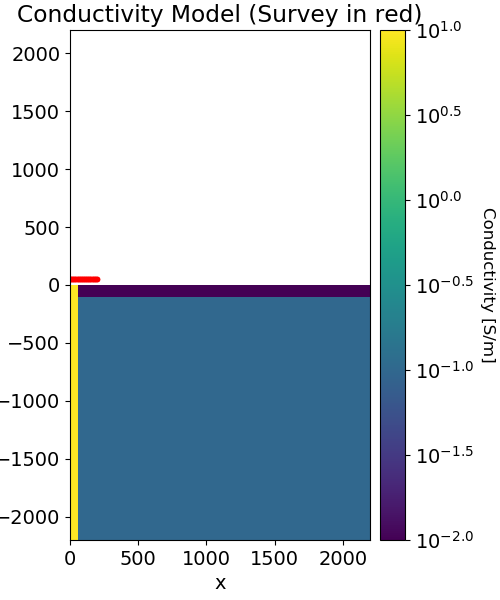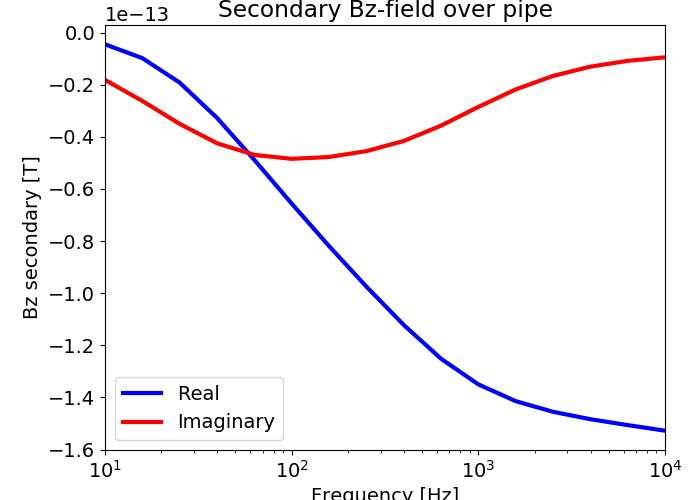Note
Click here to download the full example code
Forward Simulation on a Cylindrical Mesh¶
Here we use the module SimPEG.electromagnetics.frequency_domain to simulate the FDEM response for an airborne survey using a cylindrical mesh and a conductivity model. We simulate a single line of airborne data at many frequencies for a vertical coplanar survey geometry. For this tutorial, we focus on the following:
How to define the transmitters and receivers
How to define the survey
How to solve the FDEM problem on cylindrical meshes
The units of the conductivity/resistivity model and resulting data
Please note that we have used a coarse mesh to shorten the time of the simulation. Proper discretization is required to simulate the fields at each frequency with sufficient accuracy.
Import modules¶
from discretize import CylMesh
from discretize.utils import mkvc
from SimPEG import maps
import SimPEG.electromagnetics.frequency_domain as fdem
import numpy as np
import matplotlib as mpl
import matplotlib.pyplot as plt
try:
from pymatsolver import Pardiso as Solver
except ImportError:
from SimPEG import SolverLU as Solver
write_file = False
# sphinx_gallery_thumbnail_number = 2
Create Airborne Survey¶
Here we define an airborne survey that consists of a single line of EM data measurements over a range of frequencies. The loop geometry is horizontal coplanar.
# Frequencies being predicted (10 Hz to 10000 Hz)
frequencies = np.logspace(1, 4, 16)
# Defining transmitter locations
xtx, ytx, ztx = np.meshgrid(np.linspace(0, 200, 41), [0], [55])
source_locations = np.c_[mkvc(xtx), mkvc(ytx), mkvc(ztx)]
ntx = np.size(xtx)
# Define receiver locations
xrx, yrx, zrx = np.meshgrid(np.linspace(0, 200, 41), [0], [50])
receiver_locations = np.c_[mkvc(xrx), mkvc(yrx), mkvc(zrx)]
source_list = [] # Create empty list to store sources
# Each unique location and frequency defines a new transmitter
for ii in range(ntx):
# Define receivers of different types at each location. Real and imaginary
# measurements require separate receivers. You can define the orientation of
# the transmitters and receivers for different survey geometries.
bzr_receiver = fdem.receivers.PointMagneticFluxDensitySecondary(
receiver_locations[ii, :], "z", "real"
)
bzi_receiver = fdem.receivers.PointMagneticFluxDensitySecondary(
receiver_locations[ii, :], "z", "imag"
)
receivers_list = [bzr_receiver, bzi_receiver] # must be a list
for jj in range(len(frequencies)):
# Must define the transmitter properties and associated receivers
source_list.append(
fdem.sources.MagDipole(
receivers_list, frequencies[jj], source_locations[ii], orientation="z"
)
)
# Define the survey
survey = fdem.Survey(source_list)
Create Cylindrical Mesh¶
Here we create the cylindrical mesh that will be used for this tutorial example. We chose to design a coarser mesh to decrease the run time. When designing a mesh to solve practical frequency domain problems:
Your smallest cell size should be 10%-20% the size of your smallest skin depth
The thickness of your padding needs to be 2-3 times biggest than your largest skin depth
The skin depth is ~500*np.sqrt(rho/f)
Create Conductivity/Resistivity Model and Mapping¶
Here, we create the model that will be used to predict frequency domain data and the mapping from the model to the mesh. The model consists of a long vertical conductive pipe and a resistive surface layer. For this example, we will have only flat topography.
# Conductivity in S/m (or resistivity in Ohm m)
air_conductivity = 1e-8
background_conductivity = 1e-1
layer_conductivity = 1e-2
pipe_conductivity = 1e1
# Find cells that are active in the forward modeling (cells below surface)
ind_active = mesh.gridCC[:, 2] < 0
# Define mapping from model to active cells
model_map = maps.InjectActiveCells(mesh, ind_active, air_conductivity)
# Define the model
model = background_conductivity * np.ones(ind_active.sum())
ind_layer = (mesh.gridCC[ind_active, 2] > -100.0) & (mesh.gridCC[ind_active, 2] < -0)
model[ind_layer] = layer_conductivity
ind_pipe = (
(mesh.gridCC[ind_active, 0] < 60.0)
& (mesh.gridCC[ind_active, 2] > -10000.0)
& (mesh.gridCC[ind_active, 2] < 0.0)
)
model[ind_pipe] = pipe_conductivity
# Plot Conductivity Model
mpl.rcParams.update({"font.size": 14})
fig = plt.figure(figsize=(5, 6))
plotting_map = maps.InjectActiveCells(mesh, ind_active, np.nan)
log_model = np.log10(model)
ax1 = fig.add_axes([0.14, 0.1, 0.6, 0.85])
mesh.plotImage(
plotting_map * log_model,
ax=ax1,
grid=False,
clim=(np.log10(layer_conductivity), np.log10(pipe_conductivity)),
)
ax1.set_title("Conductivity Model (Survey in red)")
ax1.plot(receiver_locations[:, 0], receiver_locations[:, 2], "r.")
ax2 = fig.add_axes([0.76, 0.1, 0.05, 0.85])
norm = mpl.colors.Normalize(
vmin=np.log10(layer_conductivity), vmax=np.log10(pipe_conductivity)
)
cbar = mpl.colorbar.ColorbarBase(
ax2, norm=norm, orientation="vertical", format="$10^{%.1f}$"
)
cbar.set_label("Conductivity [S/m]", rotation=270, labelpad=15, size=12)

Simulation: Predicting FDEM Data¶
Here we define the formulation for solving Maxwell’s equations. Since we are measuring the magnetic flux density and working with a conductivity model, the EB formulation is the most natural. We must also remember to define the mapping for the conductivity model. If you defined a resistivity model, use the kwarg rhoMap instead of sigmaMap
simulation = fdem.simulation.Simulation3DMagneticFluxDensity(
mesh, survey=survey, sigmaMap=model_map, Solver=Solver
)
Predict and Plot Data¶
Here we show how the simulation is used to predict data.
# Compute predicted data for the given model.
dpred = simulation.dpred(model)
# Data are organized by transmitter location, then component, then frequency. We had nFreq
# transmitters and each transmitter had 2 receivers (real and imaginary component). So
# first we will pick out the real and imaginary data
bz_real = dpred[0 : len(dpred) : 2]
bz_imag = dpred[1 : len(dpred) : 2]
# Then we will will reshape the data.
bz_real = np.reshape(bz_real, (ntx, len(frequencies)))
bz_imag = np.reshape(bz_imag, (ntx, len(frequencies)))
# Plot secondary field along the profile at f = 1 Hz
fig = plt.figure(figsize=(7, 5))
ax1 = fig.add_axes([0.15, 0.1, 0.8, 0.85])
frequencies_index = 0
ax1.plot(receiver_locations[:, 0], bz_real[:, frequencies_index], "b", lw=3)
ax1.plot(receiver_locations[:, 0], bz_imag[:, frequencies_index], "r", lw=3)
ax1.set_xlim((0, np.max(xtx)))
ax1.set_xlabel("Easting [m]")
ax1.set_ylabel("Bz secondary [T]")
ax1.set_title("Secondary Bz-field at 1 Hz")
ax1.legend(["Real", "Imaginary"], loc="lower right")
# Plot FEM sounding over the pipe
fig = plt.figure(figsize=(7, 5))
ax1 = fig.add_axes([0.15, 0.1, 0.8, 0.85])
location_index = 0
ax1.semilogx(frequencies, bz_real[location_index, :], "b", lw=3)
ax1.semilogx(frequencies, bz_imag[location_index, :], "r", lw=3)
ax1.set_xlim((np.min(frequencies), np.max(frequencies)))
ax1.set_xlabel("Frequency [Hz]")
ax1.set_ylabel("Bz secondary [T]")
ax1.set_title("Secondary Bz-field over pipe")
ax1.legend(["Real", "Imaginary"], loc="lower left")
Out:
<matplotlib.legend.Legend object at 0x192cef9b00>
Total running time of the script: ( 0 minutes 8.867 seconds)

